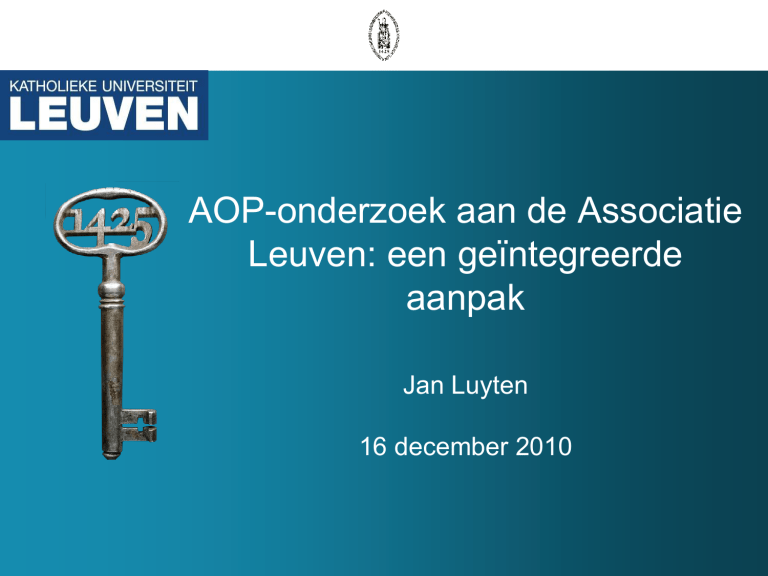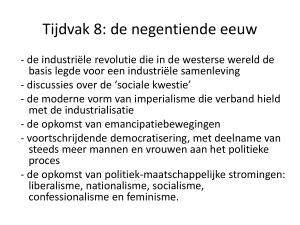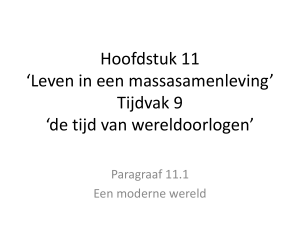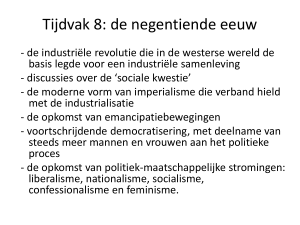
AOP-onderzoek aan de Associatie
Leuven: een geïntegreerde
aanpak
Jan Luyten
16 december 2010
Inleiding
• Wat zijn AOP’s?
Primair oxidans ontbindt onder matige omstandigheden in een
secundair oxidans met een hogere oxidatiepotentiaal dan het primair
oxidans.
Inleiding
• Problematiek: Europese Kaderrichtlijn Water:
de volledige eliminatie van prioritaire gevaarlijke stoffen en in het bijdragen
aan het bereiken van concentraties in het mariene milieu in de nabijheid van
de achtergrondwaarden van natuurlijke in het milieu aanwezige stoffen.
Bron: Vlaamse Milieumaatschappij, data 2006
Inleiding
• Wat kunnen AOP’s?
Toepassingsdomeinen:
• Tertiaire zuivering (effluent
polishing)
• Partiële oxidatie:
chemische transformatie
naar producten met een
verbeterde biodegradeerbaarheid of adsorptie op
actieve kool
Inleiding
• Ervaringen met AOP’s:
IWT-TETRA project ‘EconAOP’ (2008-2009)
‘De economische verantwoorde inzet van Geavanceerde
Oxidatieprocessen in klassieke waterzuiveringsinstallaties’
IWT-TETRA project ‘AOPselect’ (2010-2011)
Karakterisatie en optimalisatie van continue installaties voor de
selectieve verwijdering van probleem-componenten met behulp
van AOP’s
Inleiding
• Beschikbare infrastructuur op Campus De Nayer
Inleiding
• AOP’s voor industriële afvalwaters: algemeen
Interval Plot of CODbegin vs behandeling
95% CI for the Mean
CODbegin
20000
15000
10000
5000
0
F
O3
2
e
f
n
to
n
e
f
to
o
f
n
to
n
e
V
O2
/U
2
3
H
O
V/
U
/
O3
on
oz
x
ro
e
p
on
O2
Ti
tr
ul
t
le
iv o
a
UV
O2
2
/H
w
behandeling
e
at
e
id
x
ro
pe
f
to
rs
Inleiding
• AOP’s voor industriële afvalwaters: algemeen
Interval Plot of %CODverwijdering vs sector
95% CI for the Mean
%CODverwijdering
100
90
80
70
60
50
40
30
20
r
r
r
r
rt
ie
ti e
te
ie
i ca
te
to
c
t
to
m
a
p
a
c
s
u
u
e
w
w
pa
se
ce
od
ch
al
er
al
n
r
a
t
e
o
v
v
f
p
r
a
f
h
e
t
r
m
a
a
c
lp
te
h
ar
pe
gw
fis
jk
u
s
c
h
o
i
a
r
l
p
p
is
lo
gr
de
lye
et
u
o
h
p
nt
ho
is
sy
u
h
sector
l
ti e
x
te
ng
di
e
vo
w
se
s
a
rij
Inleiding
• AOP’s voor industriële afvalwaters: Wasserijsector
500
1
400
0,8
300
0,6
200
0,4
100
0,2
0
0
0%
5%
10%
15%
dosering
20%
100%
BOD/COD
BOD, COD
CO
BO
BO
Inleiding
• AOP’s voor industriële afvalwaters: Wasserijsector
Inleiding
• AOP’s voor industriële afvalwaters: Chemische sector
3 piloot-opstellingen (1m3 AC) in parallel:
Zonder beluchting (1)
Klassieke AC-filtratie
Met beluchting (2)
AC-filtratie, oxidatie, biologie
Met O3 en beluchting (3) AC-filtratie, verhoogde oxidatie?,
biologie?
3
1
2
Inleiding
• AOP’s voor industriële afvalwaters: Grafische sector
Inleiding
• Stand van zaken:
Inleiding
• Advances and future trends for R&D (Comninellis et al.):
–
–
–
–
development of new materials to promote efficient treatment,
strategies for process integration,
process scale−up and commercialisation,
targeting new classes of pollutants and contaminants.
Referentie: C. Comninellis , A. Kapalka,S. Malato, S.A. Parsons, I. Poulios and D.
Mantzavinos, Advanced oxidation processes for water treatment: advances and trends
for R&D, Journal of Chemical Technology and Biotechnology 83 (2008) 769–776.
Inleiding
• Kennisplatform Industrieel Onderzoeksfonds (IOF)
Integration and optimisation of Advanced Oxidation Processes for
wastewater treatment: a multi-scale approach (AOPtimise)
AOPtimise
• Deelnemende groepen …
– Lessius Mechelen, Campus De Nayer, Dept. IW: Onderzoeksgroep
Environmental and process technology: Jan Luyten, Sven Liers, Raf Dewil,
Ann Hulsmans
– K.U.Leuven, Dept. CIT: Afd. (Bio)Chemical Process Technology and
Control: Jan van Impe, Jan Degrève
– K.U.Leuven, Dept. CIT: Afd. Applied Physical Chemistry and
Environmental Technology: Tom van Gerven
– K.U.Leuven, Dept. M²S: Centre for Surface Chemistry and Catalysis:
Johan Martens
– Lessius Mechelen, Campus De Nayer, Dept. IW: Onderzoeksgroep
Microbial Process Ecology and Management: Kris Willems
– KHBO, Dept. IW&T: Afd. Chemistry: Boudewijn Meesschaert
– K.U.Leuven, Dept. Chemie: Afd. Molecular Design en Synthesis: Chris
Vinckier
– KHLim, Dept. IW&T: Afd. Chemistry: Leen Braeken
– KHLeuven, Dept. Gezondheidszorg en Technologie, Afd. Chemistry:
Thomas Scheers
AOPtimise
• … werken samen aan een geïntegreerde aanpak
Keywords PhD’s:
PhD1: Photocatalysis
PhD2: Process intensification, photocatalytic reactor
PhD3: Monitoring, toxicity aspects
PhD4: Monitoring, advanced process control
PhD5: Integration in WWTP, reactor simulation
PhD6: Impact of AOP on biological treatment
AOPtimise
• Wetenschappelijke doelstellingen AOPtimise:
– evaluation of innovative AOPs with special emphasis on
photocatalysis,
– intensification of the reactor equipment for promising AOPs
focussing on UV-based (photocatalytic) processes and
– optimal integration of AOPs in wastewater treatment plants
including process control based on rapid toxicity measurements.
• Hoe?
– Meer fundamentele wetenschappelijke en technologische
problemen in 6 PhD’s (4 gefinancierd door KP, 2 extern
gefinancierd)
– Meer toegepast wetenschappelijk onderzoek: gezamenlijke
projecten tussen verschillende partners
Werking AOPtimise
• Consortium meetings:
– 2 x per jaar
– Intentieverklaring
– Industriële partners zijn waarnemend/raadgevend lid
• Organisatie van studiedagen en events
• Lanceer-event: vrijdag 18 februari 2011
Werking AOPtimise
• Contact: Ann Hulsmans (platform coordinator)
[email protected]
• More information (soon) at www.aoptimise.be
• Kernteam:
Jan Luyten
Raf Dewil
Ann Hulsmans
Jan Van Impe












